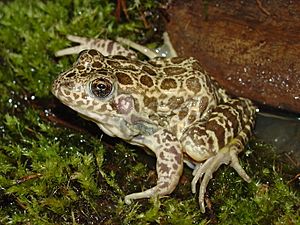Crawfish frog facts for kids
Quick facts for kids Crawfish frog |
|
|---|---|
 |
|
| Conservation status | |
| Scientific classification | |
| Synonyms | |
|
Rana circulosa Rice & Davis, 1878 |
The crawfish frog (Lithobates areolatus) is a medium-sized frog that lives in the prairies and grasslands of the central United States. It gets its name because it spends most of the year living inside burrows made by crayfish. These frogs have cool golden or black circles all over their bodies.
Contents
What Does a Crawfish Frog Look Like?
The crawfish frog can grow to be about 2.2 to 3.0 inches (5.6 to 7.6 cm) long. Its color can range from yellow to brown, and its belly is white. You'll notice many dark brown spots on its back, and each spot has a light-colored ring around it.
This frog also has special skin folds on each side of its back. These folds are much easier to see on male frogs than on females. It also has a fairly small ear drum (tympanum).
How Do Crawfish Frogs Live?
Crawfish frogs mostly live in prairie or grassland areas. They can also be found in pastures and overgrown fields. For most of the year, they stay close to a crayfish burrow. This burrow is super important for them!
Why Burrows Are Important
The burrow acts like a safe home for the frog. It helps them:
- Hide from animals that want to eat them.
- Stay hydrated by providing a source of water.
- Escape from grassland fires.
- Get deep enough underground to avoid freezing in winter.
What Do They Eat?
Crawfish frogs are not picky eaters. They eat insects and other small creatures that happen to pass by their burrow.
How Do They Reproduce?
Crawfish frogs usually breed after warm, rainy weather in mid-March. In warmer southern areas, they might breed even earlier.
- Finding a Mate: During breeding season, male frogs look for temporary ponds and wetlands that don't have fish. They start making loud, low-pitched calls that can travel over a mile! These calls attract female frogs from the surrounding areas.
- Laying Eggs: Once the females arrive, the frogs mate, and the female lays up to 7,000 eggs at once. The eggs are laid in large, round masses.
- Tadpoles to Frogs: The eggs hatch in about 12 days. The tadpoles then take about three or four months to change into small froglets through a process called metamorphosis.
- Finding a Home: These new, young frogs must quickly find a crayfish burrow to live in so they can stay safe from predators.
- Lifespan: Crawfish frogs become old enough to reproduce when they are two or three years old. They can live for up to seven years or even longer in the wild.
Where Do Crawfish Frogs Live?
The crawfish frog is found in areas that used to be prairies. This includes states like Indiana in the east, stretching west to Kansas, south to Texas, and east to Mississippi.
Sadly, these frogs have disappeared from many places where they used to live. The groups of frogs that are left are often small and separated from each other. In 2016, a good-sized group was found in Sumter County, Alabama. Also, in 2017, a new record was made in Perry County, Arkansas, within the Ouachita Mountains.
Types of Crawfish Frogs
There are two main types, or subspecies, of the crawfish frog:
- Southern crawfish frog, L. a. areolatus (Baird & Girard, 1852)
- Northern crawfish frog, L. a. circulosus (Davis and Rice, 1883)
Are Crawfish Frogs in Danger?
The crawfish frog is listed as "near threatened" by the IUCN Red List of Threatened Species. This means they could become endangered soon. In some states, like Iowa (where they might have already disappeared) and Indiana, they are listed as endangered.
The biggest problem for these frogs is habitat loss, which means their homes are being destroyed. Other problems include a disease called chytridiomycosis and competition from other frogs.
See also
 In Spanish: Lithobates areolatus para niños
In Spanish: Lithobates areolatus para niños


